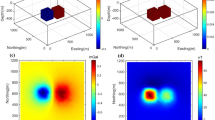Abstract
Magnetic anomalies are interpreted for subsurface geological information. Three-dimensional inversion of magnetic data is a challenging quantitative approach for interpreting the data. The rapid iterative migration technique could be a good and fast alternative for the inversion method. The focusing iterative migration that employs a focusing stabilizer can generate focused migration models which justify geological interfaces, adequately. This paper introduces a new algorithm using a relaxed steepest descent method and a sigmoid stabilizer for fast focusing migration of magnetic fields. The developed method can improve the computational efficiency of focusing iterative migration by reducing the required iterations. The better performance of the new method is demonstrated by two numerical models and a real case study. The magnetic anomaly over San Nicolas massive sulfide deposit in Mexico is used for the case study. Compared with the drilling information, the iterative migration methods produce robust migration models for the San Nicolas deposit.









Similar content being viewed by others
References
Abedi M, Gholami A, Norouzi GH, Fathianpour N (2013) Fast inversion of magnetic data using Lanczos bidiagonalization method. J Appl Geophys 90:126–137
Baniamerian J, Fedi M, Oskooi B (2016) Research note: compact depth from extreme points: a tool for fast potential field imaging. Geophys Prospect 64:1386–1398
Chianese D, Lapenna V (2007) Magnetic probability tomography for environmental purposes: test measurements and field applications. J Geophys Eng 4:63–74
Ding Y, Ma G, Xiong S, Wang H (2020) Three-dimensional regularized focusing migration: a case study from the Yucheng Mining area, Shandong, China. Miner 10:471
Farquharson CG (2008) Constructing piecewise-constant models in multidimensional minimum-structure inversions. Geophysics 73:K1–K9
Fedi M (2007) DEXP: A fast method to determine the depth and the structural index of potential fields sources. Geophysics 72:I1–I11
Fedi M, Pilkington M (2012) Understanding imaging methods for potential field data. Geophysics 77:G13–G24
Foks NL, Krahenbuhl R, Li Y (2014) Adaptive sampling of potential-field data: a direct approach to compressive inversion adaptive sampling and compressive inversion. Geophysics 79:IM1–IM9
Hornby P, Boschetti F, Horowitz FG (1999) Analysis of potential field data in the wavelet domain. Geophys J Int 137:175–196
Li Y, Oldenburg DW (1996) 3-D inversion of magnetic data. Geophysics 61:394–408
Li Y, Oldenburg DW (1998) 3-D inversion of gravity data. Geophysics 63:109–119
Liu CS (2013) An optimally generalized steepest-descent algorithm for solving ill-posed linear systems. J Appl Math 2013:154358
Liu S, Baniamerian J, Fedi M (2019) Imaging methods versus inverse methods: an option or an alternative? IEEE Trans Geosci Remote Sens 58:3484–3494
Luo Y, Yao L (2007) Theoretical study on cuboid magnetic field and gradient expression without singular point. Oil Geophys Prospect 42:714–719
Mauriello P, Patella D (2001) Gravity probability tomography: a new tool for buried mass distribution imaging. Geophys Prospect 49:1–12
Mehanee SA, Zhdanov MS (2002) 3-D finite difference iterative migration of the electromagnetic field. In: SEG Technical Program Expanded Abstracts 2002, Society of Exploration Geophysicists, pp 657–660
Meng Z, Li W, Li F, Li H (2020) Projected Barzilai-Borwein method for the acceleration of gravity field data inversion. Explor Geophys. https://doi.org/10.1080/08123985.2020.1814140
Pedersen LB (1991) Relations between potential fields and some equivalent sources. Geophysics 56:961–971
Phillips N, Oldenburg D, Chen J, Li Y, Routh P (2001) Cost effectiveness of geophysical inversions in mineral exploration: applications at San Nicolas. Lead Edge 20:1351–1360
Pilkington M (2009) 3D magnetic data-space inversion with sparseness constraints. Geophysics 74:L7–L15
Portniaguine O, Zhdanov MS (1999) Focusing geophysical inversion images. Geophysics 64:874–887
Portniaguine O, Zhdanov MS (2002) 3-D magnetic inversion with data compression and image focusing. Geophysics 67:1532–1541
Rezaie M (2019) 3D non-smooth inversion of gravity data by zero order minimum entropy stabilizing functional. Phys Earth Planet In 294:106275
Rezaie M (2020) A sigmoid stabilizing function for fast sparse 3D inversion of magnetic data. Near Surf Geophys 18:149–159
Rezaie M, Moradzadeh A, Kalate AN, Aghajani H (2017) Fast 3D focusing inversion of gravity data using reweighted regularized Lanczos bidiagonalization method. Pure Appl Geophys 174:359–374
Tu X, Zhdanov MS (2020) Enhancement and sharpening the migration images of the gravity field and its gradients. Pure Appl Geophys 177:2853–2870
Ueda T, Zhdanov MS (2008) Fast numerical methods for marine controlled-source electromagnetic (EM) survey data based on multigrid quasi-linear approximation and iterative EM migration. Explor Geophys 39:60–67
Vassallo LF, Aranda-Gómez JJ, Solorio-Munguía JG (2015) Hydrothermal alteration of volcanic rocks hosting the Late Jurassic-Early Cretaceous San Nicolás VMS deposit, southern Zacatecas. Mexico Rev Mex Cienc Geo 32:254–272
Wan L, Zhdanov MS (2013) Iterative migration of gravity and gravity gradiometry data. In SEG technical program expanded abstracts 2013. Society of Exploration Geophysicists, pp 1211–1215. https://doi.org/10.1190/segam2013-1036.1
Xu Z, Wan L, Zhdanov MS (2020) Focusing iterative migration of gravity gradiometry data acquired in the Nordkapp Basin, Barents Sea. Geophys Prospect 68:2292–2306
Zhdanov MS (2002) Geophysical inverse theory and regularization problems. Elsevier
Zhdanov MS (2015) Inverse theory and applications in geophysics. Elsevier
Zhdanov MS, Liu X, Wilson GA, Wan L (2012) 3D migration for rapid imaging of total-magnetic-intensity data. Geophysics 77:J1–J5
Author information
Authors and Affiliations
Corresponding author
Ethics declarations
Conflict of interest
The author declares no competing interests.
Additional information
Communicated by Michal Malinowski (CO-EDITOR-IN-CHIEF)/Ivana Vasiljevic, Ph.D. (ASSOCIATE EDITOR).
Rights and permissions
About this article
Cite this article
Rezaie, M. Fast focusing iterative migration of magnetic anomalies. Acta Geophys. 69, 1215–1224 (2021). https://doi.org/10.1007/s11600-021-00587-5
Received:
Accepted:
Published:
Issue Date:
DOI: https://doi.org/10.1007/s11600-021-00587-5




